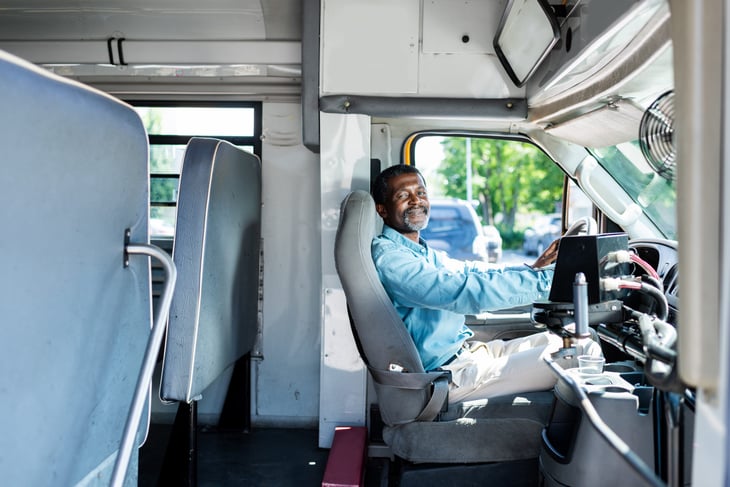
The COVID-19 pandemic has triggered a stunning reversal for the previously humming American economy.
The economic gut punch could be particularly tough for people aged 55 and older, who prior to the pandemic comprised nearly one fourth of the entire U.S. workforce. And COVID-19 also delivers a double-whammy: Many seniors have jobs that cannot be done remotely, and many will not be able to easily re-enter the workforce because of a disease that has disproportionately afflicted older folks.
SeniorLiving.org recently took a look at professions that are most affected by the pandemic and have the highest share of older workers, and at other data from a demographic sector that has become increasingly more important to the American economy and, unfortunately, one of the most devastated by the coronavirus crisis.
Following are the coronavirus-impacted jobs with the largest shares of workers age 55 or older.
10. Taxi drivers and chauffeurs

Share of workers age 55 or older in this job: 33%
The Metropolitan Taxicab Board of Trade said that the number of cab rides in New York City fell from 506,000 in early March to 28,500 in early May and that overall fares dropped 94% during that period. In normal circumstances, cabbies can expect to make median amounts of $25,980 per year and $12.49 per hour, according to the U.S. Bureau of Labor Statistics.
9. Flight attendants

Share of workers age 55 or older in this job: 34%
United Airlines reportedly will only need 3,000 of its 25,000 flight attendants in June amid a flying schedule that has dropped 90% amid the pandemic. That’s a tough economic blow for a group of workers that typically earn $56,640 per year, are able to travel the world and whose educational prerequisite is only a high school diploma.
8. Aircraft pilots and flight engineers

Share of workers age 55 or older in this job: 34%
Delta Airlines reportedly told its 14,500 pilots that nearly half of them would not be needed in the fall, with the airline industry losing an overall $10 billion in cash per month amid the pandemic. Even with some pilots having to retire because they will turn 65, Delta estimates it will still have too many pilots by summer of 2021.
Prior to the COVID-19 crisis, the Bureau of Labor Statistics forecast 6% in job growth for pilots, who make a median income of $121,430 per year.
7. Baggage porters, bellhops and concierges

Share of workers age 55 or older in this job: 35%
On May 20, the American Hotel & Lodging Association said the hotel industry was “on the brink of collapse” after the Bureau of Labor Statistics reported a 47% drop in employment for April in the leisure and hospitality industry. With 7.7 million jobs lost, the BLS said that industry was the hardest-hit sector of the economy.
As 2019, there were 41,670 concierges in the U.S. and 39,790 baggage porters and bellhops.
6. Travel agents

Share of workers age 55 or older in this job: 35%
This sector’s job force was already projected to decline 6% from 2018 to 2028, but COVID-19 has been a sledgehammer to its nearly 79,000 workers. Analytical and forecasting firm Oxford Economics predicted a $519 billion loss for the travel industry in 2020 and a loss of 8 million jobs for the year because of the decline in travel.
5. Door-to-door sales workers, news and street vendors

Share of workers age 55 or older in this job: 36%
This sector of the economy accounts for nearly 10,000 workers, but the nationwide lockdown and restrictions on movement are preventing the kind of close personal contact required for these gigs. Under normal circumstances, folks in these professions make median incomes of $12.71 per hour and $26,430 per year.
4. Transportation attendants (excluding flight attendants)

Share of workers age 55 or older in this job: 40%
This backbone of people-moving industries provides a range of services on ships, trains, buses and in terminals, including:
- Serving meals and beverages
- Greeting passengers
- Explaining safety equipment
These workers earn a mean hourly wage of $14.73 and a mean annual wage of $30,640. But those numbers are taking a hit with the massive decline in domestic and international travel. Amtrak ridership has dropped 95% and 90% of motorcoaches have been sidelined amid the pandemic.
3. Subway, streetcar and other rail transportation workers

Share of workers age 55 or older in this job: 44%
Ridership has been down about 90% on both subways and buses in New York City, according to the Metropolitan Transportation Authority, with a slight uptick in late May as the city slowly eased its pandemic restrictions. In better times, subway and streetcar operators earn more than $30 per hour and nearly $63,000 per year nationally.
2. Bus drivers

Share of workers age 55 or older in this job: 47%
More than 90% of the nation’s bus fleet and nearly all of its 100,000 drivers (not including school bus drivers) have been furloughed amid the pandemic, according to the American Bus Association. Hundreds of buses and motorcoaches encircled the National Mall in Washington, D.C., in mid-May to call on the U.S. government to provide funding to help the industry weather the storm.
1. Motor vehicle operators

Share of workers age 55 or older in this job: 58%
There are more than 56,000 folks employed in this field, mostly in auto dealerships and auto equipment rental and leasing companies. The states with the most of these workers are:
- California (5,590)
- North Carolina (3,690)
- Colorado (3,320)
- New York (3,300)





Add a Comment
Our Policy: We welcome relevant and respectful comments in order to foster healthy and informative discussions. All other comments may be removed. Comments with links are automatically held for moderation.